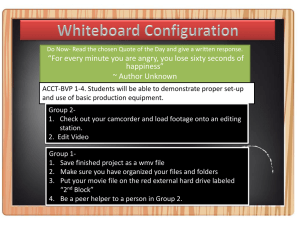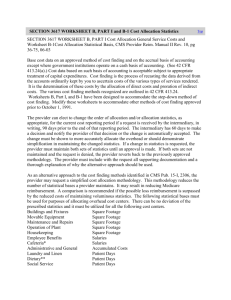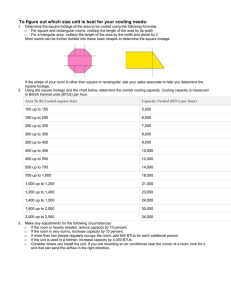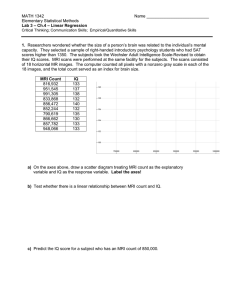Document 10999802
advertisement
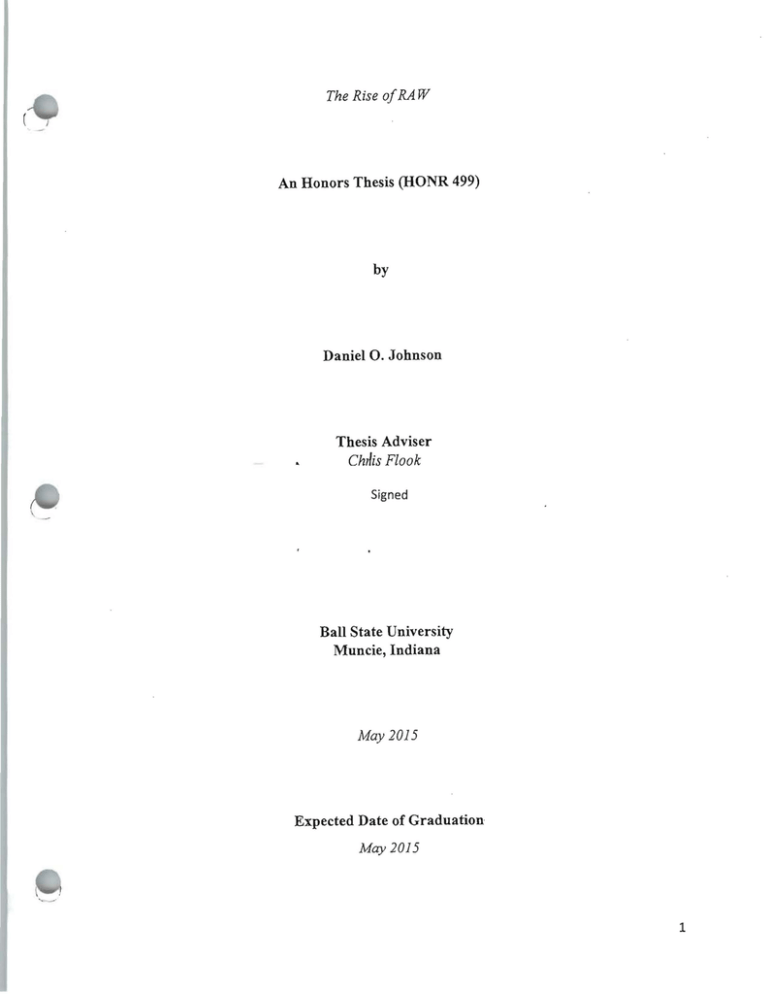
The Rise ofRA W An Honors Thesis (HONR 499) by Daniel O. Johnson Thesis Adviser ChTiis Flook Signed Ball State University Muncie, Indiana May 2015 Expected Date of Graduation May 2015 1 Abstract Over the past decade or so, digital video has seen an enormous increase in popularity as technology improves and both amateurs and professionals alike make the switch from film to digital. Along with an increase in camera hardware, compression software has been improved drastically, allowing users a variety of options for every potential situation. Perhaps one ofthe fastest growing codec categories is the group of camera RAW codecs. By removing the in­ camera processing associated with other codecs, RAW files allow the user more control over their images/footage at the cost of larger file sizes. I look at the technical and visual differences between some of the most standard codecs and CinemaDNG, perhaps the most popular RAW file type. I also outline a potential CinemaDNG workflow and look at the history of RAW file types and what lead to their increase in popularity over the past few years. Acknowledgements I would like to thank Chris Flook for advising me not only on this project, but on projects over the past year. His total commitment to his work, students, and community is a continuing source of inspiration. I would like to thank Aaron Webster, for providing the opportunity that fostered my love for filmmaking. I fear without it I would never have pursued film to this extent. He has been a constant resource in the fields of gaffing, lighting, and post-production. Finally I would like to acknowledge my parents for always being supportive, both financially and academically. Thanks for believing in me, even when I stopped believing in myself. 2 Author's Statement The Rise ofRA W by Daniel Johnson As time progresses, Moore's law affects all facets of technology including, but not limited to, digital video. As more and more options become accessible and eventually, affordable, artists will have to decide how to approach their projects based on personal and technical preferences, with less emphasis on monetary constrictions. The intent of this thesis project is to act as an introduction into the world ofRAW digital video, and show what benefits and drawbacks it has over more traditional codecs. Variables in this thesis like choice of codecs, cameras, and post­ production sofuvare were chosen based on average film student accessibility and industry standards. This thesis should provide the information for amateur film students to choose what format their next short ftlm will be shot and edited in based on their own criteria and priorities. With any modem digital video camera, there are two broad categories which classify how the image is captured and stored. The first method, which is found in higher end cameras, is to take the information captured by the camera's image sensor and save that information directly to the storage device. The second method is done by taking that sensor information and running it through an algorithm before storing it on the storage device. The primary purpose of this algorithm is to reduce the size of the file by reducing redundancies. These algorithms are known as a codecs. The effects of these two different capture methods however go far beyond the memory card they are stored in. The codec used by the camera determines how and to what extent one is able to alter and manipulate the footage after the initial capture. How much one is able to alter the footage will affect the quality of the final product. My thesis looks at these two broad codec types, and their effect on both the production and post-production process. The primary section compares how the various algorithms alter the 3 original information captured by the sensor on a bit by bit level. There are three characteristics found in any codec. These characteristics are complexity, compression ratio, and fidelity. The complexity of a codec determines how easy it is to execute and how resource intensive it is. The higher the complexity, the more difficult it is to execute. A lower complexity is ideal as it means more executions can be run simultaneously without interfering with other programs. (Apple) The compression ratio is the ratio which compares the size of the original file and the size of the file after it has been run through the codec's algorithm. The higher the compression ratio, the more extraneous data is able to be eliminated from the video and the smaller the video after being run through the codec. Compression ratio is important because the more a source video is able to be compressed the more total video time can be stored. (Apple) Finally the fidelity is just how accurate the video after being run through the codec is compared to the original source. The higher the fidelity a codec can provide, the closer the source material is represented by the final product. However there is a relationship between these three qualities . As will be exemplified by the next section, a codec can only perform well in two out of three of these categories. The way in which these are related means that the other category will suffer in response. (Apple) In the case of RAW codecs, the focus is put on fidelity . The only compression applied to CinemaDNG is what is called lossless compression. Lossless compression is a form of compression that is completely reversible without any data loss. Therefore, the standard traits associated with files encoded using a RAW co dec is low compression, high fidelity, and low complexity. The drawback of high fidelity and low compression is an increased file size. This increased amount of data means that special storage devices that are able to write more information, faster, are also required. (Adobe Systems Incorporated) 4 The other three codecs have varying degrees of compression ratio, complexity, and fidelity. Each puts more emphasis on one quality or another which makes them ideal in their own unique circumstances. However, compared to the raw codec, they have a higher compression ratio, higher complexity, and lower fidelity. This discussion about which codec puts emphasis on which set of traits is important. Deciding to film an entire project in RAW means that one has to have the hardware to support both the storage and processing needs. If suitable hardware is not something that you have nor have the ability to attain, than this would affect your decision on which route to take. The second section of my thesis looks at the differences between the post-production workflows of the two codec types. The post production process includes coloring the footage (both to correct for inconsistencies as well as to apply an aesthetic touch) as well as cutting the footage to craft the desired narrative. The primary difference between the two is working with RA W footage is much more complicated and time consuming. Using more common codecs, an individual could use one suite of programs that integrate together well for an easy painless experience. However, to take full advantage of the extra information stored the video of a RAW codec, an entirely separate program needs be used for the first and last steps of the process. This means a couple of conversions which add to the complexity and increase the chances of error. This difference is important as deadlines could be a factor in deciding which type of file is used . Going with a RAW file would definitely add more time in post-production, therefore not being optimal on a project with an encroaching deadline . The final section looked at the end products of both codec styles. After using the right types of cameras and their respective post-production workflows, what differences could the user expect to see? As expected using a RA W codec and workflow resulted in greater control over the 5 footage and therefore a higher quality end product. Trying to alter things like the brightness of the footage or the color in order to affect the mood looked clearer and crisper with a RAW codec. Trying to do similar functions using a more standard codec resulted in the footage looking a little more washed out. The comparison between the technical performance, post-production workflow, and final video quality ofRAWand standard codecs is important because both are viable options to amateur filmmakers in this day and age. Ten years ago, shooting digital video in a RAW codec would have been expensive, technologically impractical, and simply unheard of. Even now, in 2015, some of the more affordable natively RAW shooting cameras cost around $2,500. Even though this isn't accessible to everyone, it is merely a fraction of the cost of a RAW capable camera a decade ago. Ten years ago, a storage device with the necessary speed and memory capacity would have cost as much as the camera does today. However, with the teclmological advances of flash memory, most commonly found in thumb drives, a suitable memory card can be acquired for around $50. In short, price isn't the primary barrier of entry to using a RA W shooting digital video camera. Now, the barrier of entry is complexity, and the knowledge of how to use the added functionality. My thesis is part informative and part guide on one way to produce a video shot in a RAW codec. Some people might be up to the challenge to get that extra bit of control and overall quality that RAW video allows. Others might put more value on ease and simplicity and stick to a more understandable standard codec. My thesis is important because it acts a tool for the user to make that decision, not to make the decision for them. Perhaps the first choice that had to be made was deciding the medium in which my thesis would be delivered in. Taking into account both the intended audience as well as the subject matter, a website seemed to be the obvious choice. I wanted to look at the similarities and 6 differences between various codecs, their technical performance, and workflow limitations to better understand the medium that I hope to work in as a career. However, I wasn't making this for just myself. I wanted this website to act as a tool , to help fellow telecommunications students who were interested in the technical side of their craft. As students, we access most of our information online. Also, the artifacts I wanted to use in my thesis required a medium which could support multiple types of digital formats. If I only wanted to use still images, these could have been just as effective embedded within a research paper. However, because the subject matter is video quality comparison, an interactive digital medium was a necessity. That being said, I wanted my content to be more accessible than just a standard website. Due to the prevalence of smart phones and mobile devices, especially amongst college students, I wanted to make the information easily accessible on these platforms. There are generally two different approaches taken when an individual wants to display some content on a mobile device, either a specific mobile application or mobile website is made. Without going into too much detail, mobile applications are harder to do as it is an entirely separate entity. As opposed to a mobile website, which, if a regular website already exists, can be modified to work on both desktops and mobile devices alike. Another difficulty with displaying the information via a mobile application is that separate applications need to be made for each mobile operating system, not to mention all the different possible screen resolutions. Luckily, developing a mobile website is much easier, assuming you plan on doing it from the get go. One of the most popular tools for mobile website development is Bootstrap, designed by the same people who designed Twitter. Bootstrap is a collection of font, styles, and code that, if used correctly, create automatically scaling, responsive websites. 7 The overall purpose of my thesis was to answer the question "How is a RAW codec like CinemaDNG different from more common codecs?" Initially I was curious what made them different on a technical level. With the help of my advisor, I compiled a list of codecs to compare against CinemaDNG. This was one of the first major decisions of the project. This decision was primarily based on popularity in the workplace and industry. By this I mean that the codecs chosen were based on which ones were most common used . I didn't need to look at statistics to see which ones were most common, I used my five years at Ball State to determine which video types I had seen and which ones were the most often used by students, seeing as that was my intended audience. Another deciding factor in determining which codecs to use in my comparison was the specialty of each codec. Each codec has a different set of pros and cons that make it applicable for its own particular use . For example the MPEG-2 codec has good compression ratio, is relatively simple compared to MPEG-4 while maintaining a similar fidelity. MPEG-2 has been traditionally used in the compression of video for DVD 's. (United States Government) MPEG-4 on the other hand, puts more effOli into providing a higher compression ratio. By having a more complex algorithm, it is able to achieve a similar encoding fidelity as MPEG-2, but at a lower file size. MPEG-4 is therefore ideal for use in internet video streaming, HD television, and HD and Blu-ray discs. (Hermans) Both MPEG-2 and MPEG-4 are examples of codecs that would be used to export a final product for consumer use. This is in contrast to the final codec, Apple ProRes. Apple ProRes, is what is known as an intermediate codec. An intermediate codec is a codec that is designed to be used in the post production process, and not as a final deliverable. The goal of an intermediate codec is to reduce file sizes as much as possible while keeping the 8 fidelity as high as possible. As a result, Apple ProRes has a relatively low compression ratio and complexity, but very high fidelity. (Apple) From this point on llet my own curiosities dictate which topics to progress towards. Now that I knew how the various codecs worked on a technical level, I wanted to know how these technical differences would affect the post-production process as well as the overall final quality. The first step was choosing the appropriate encoding format to compare to CinemaDNG, and then choosing a corresponding camera that was capable of filming in that format. Due to its common use in Blu-ray's and HDTV, I chose to use MPEG-4, and more specifically H.264 as the alternate codec. Now, in terms of cameras, the MPEG-4 video was provided by a Canon EOS SD Mark III, while the CinemaDNG RAW footage was provided by a Blackmagic Cinema Camera 2.Sk. These cameras were primarily used due to their ease of access through the Ball State University teleplex. However, they are still comparable, as the point of interest was the codec in which they recorded in . The primary confliction between the two was the different sensors. This just meant that I wasn't able to use the exact same settings between the two cameras in order to get a completely objective comparison. The zoom, ISO, and f-stop used on the Canon would result in a cropped, overexposed image in the Blackmagic. As such, I had to do my best to match the footage on location, which is why the framing is slightly different in the comparison video . The final element of my thesis was the post-production process in its entirety. I wanted to look at the differences between a workflow consisting of just MPEG-4 footage and a workflow consisting of just CinemaDNG footage. The programs which I chose to use were the Adobe Suite and Davinci Resolve Lite. The Adobe Suite is an excellent option for editing MPEG-4 footage because of how well the programs are integrated with each other. This means you can color, edit, and introduce composite effects into your footage seamlessly. For students this software package 9 runs about twenty dollars a month. This might seem like a lot, but comparatively, it is just a little bit more than a subscription to NetUix and Hulu. There are pros and cons to the RAW video workflow. One benefit is that you can have a lot more control over your footage, and you don't have to spend any extra money if you don't want to. Unfortunately, the Adobe suite does not support RAW file types like CinemaDNG or RED. However, there are some fantastic programs which do support RAW files which are available for no cost. The program I used in my final comparison was Davinci Resolve Lite by Blackrnagic Design. Davinci is a program that allows you to utilize the extra information stored in RAW files to unlock the most control over your final product. The one downside is that while Davinci is a very powerful coloring program, the editing functionality leaves a lot to be desired. This means that using a program like Adobe Premiere or Final Cut for cutting and rearranging footage is all but essential. It is a bit of a process correctly migrating the footage from Davinci to Premiere and back in such a way that no quality is sacrificed. However, due to the program's amazing capabilities and its non-existing monetary price point, I myself believe it to be worth the initial headache. After a few projects are run through this workflow, the process will become second nature. As technology becomes cheaper and more advanced the deciding factor which determines which format to use is shifting from the filmmaker's wallet to their knowledge, time, and willingness to learn something new. While, admittedly, a RAW workflow is still more expensive due to newer technology like solid state drives and better editing station specifications, it is not out of reach. The two sets of footage examined in the final video comparison of this thesis were produced with the only difference being the camera in which the initial footage was captured on. All formats that were examined were chosen due to their popularity in the industry. 10 The cameras were chosen based on their ability to capture footage in the specified format as well as being accessible through my university. Finally the programs used to color and edit the footage were chosen due to their popularity amongst amateur film makers or their price. I tried to make all decisions with the audience in mind. I am a student and I made this tool for students to help them decide for themselves which method to use. Each has their pros and cons, and my goal was to never suggest which workflow was better, but to merely provide the tools to my audience to decide for themselves. 11 Supplements My thesis is in the form of a website and can be found at: http://doj oh nson.iwe b.bsu. duiHonors_Thesi _ Website/index.htm l 12 Works Cited Adcock, Gary. Pro Video Coalition. 9 March 2009. Web Page. March 2015. <http://provideocoalition.com/prores_ a_closer_lookJpage-2> . Adobe Systems Incorporated. "CinemaDNG Image Data Format Specifications." Verso 1.1.0.0. September 2011. Adobe Systems Incorporated Web Site. January 2015. <w"vw .adobe. com>. Apple. "Apple ProRes." June 2012. Apple Website. Electronic White Paper. March 2015. <https://v;ww.appte.con fina l-cll l-pro/do<.:s/Appl ProRes \\ 1ite Pa per.pJI>. Blackmagic Design. Blackmagic Design Press Releases. 12 November 2013. Online Press Release. <https:llwwvv. blackmagicdesign.comlpress/release/20 131112-0 1> . Edwards, Benj. Evolution of the Solid-State Drive. 17 January 2012. Online Article. April 2015 . <http://www.pcworld.com/article/246617/evolution_oCthe_solid_state _ drive.html#slide 1>. Hermans, Alexander. H.264/MPEG-4 Advanced Video Coding. Seminar Report. Aachen: Rheinisch-Westfaelische Technische Hochschule University, 2012. Electronic PDF. March 2015. <http://tcs .rwlh­ aachen.de/leille/Komprimierung/S J 0 12 /au sarbe it u n ~ellIH264 - MPE G4 . pd f> . Hewlett Packard. "Keysight Technologies." Febuary 2004. Keysight Technologies Web site. Powerpoint. March 2015. <http://www. kevi£ht. com/uploadicmc upl oadJAIl!6C06MPEGTUTORJAL1.pdf?&cc= US&Jc=em~> . Mathur, Mridul Kumar, Seema Loonker and Dr. Dheeraj Saxena. "Lossless Huffman Coding Technique for Image Compression and Reconstruction Using Binary Trees." International Journal of Computer Technology and Applications 3.1 (2012): 76-79. Electronic Document. April 5015. <http :// ~ww.ijcta.com /d ocum ents/volumes ;vo13issuel /i jctalOl i030 114.pdf> . 13 Petrie, Eric C. What the Heck is the Difference Between 4K, RA \\', and Uncompressed. 29 July 2013. Website. April 2015 . <htlp ://provideoundtape.co m/blog/?p=224>. RED Digital Cinema. The Bayer Sensor Strategy. 4 December 2012. Website. Febuary 2015 . <http://www.red.comllearnlred-l 0 Ilbayer-sensor-strategy>. Reichmann, Michael. The Raw Flaw. 13 January 2009.21 April 2015 . <https://luminous­ landscape.comlthe-raw-flaw/> . United States Government. Sustainability of Digital Formats PlaIUling for the Library of Congress Collections. 2003; 2004. Website. March 2015. <http://www.digitalpreservation.gov /formats/fdd/fdd000081.shtml>. 14 http: //dojohnson.iweb.bsu.edulHOnors_Thesis_ Website/ index .html# CinemaDNG - Home Cinema RAW and Standard Codecs This website will act as my Honors College thesis at Ball State University. This thesis will explore raw image formatting for digital video, with a particular emphasis on CinemaDNG. SpecificaLLy, I will be comparing RAW video against industry standard codecs Like MPEG-2, MPEG-4, and Apple ProRes. (history.htmL) (technicaL.htmL) History In this section I will look at the history of RAW video. I want to look at the genesis of the raw file type, how it has evolved, and why it has grown in popularity recently. 1 of 1 Technical Visual This section will serve as a technical comparison between RAW video file types Like CinemaDNG and more standard video file types and the codecs behind them. I will compare how the video is captured by the camera, and what type of compression is used in condensing the file size. A primarily visual comparison between CinemaDNG file and a (Insert File Type Here) file. Two video clips of a similar subject matter will both be run through the post production process to demonstrate the amount of control one has over each. (visuaL.htmL) (workfLow.htmL) Workflow Less of an objective comparison, and more of a subjective experience between the two post production processes. Due to the size and the required data rate, RAW files are more taxing to run through the post production process. 7116/20155 :08 PM http: //dojohnson.iweb.bsu.edulHOnors_Thesis_ Websitelhistory.htm I RAW - History A H~isotry, or Lack Thereof My originaL pLan was to compiLe a brief history of RAW fiLe types, Looking at the genesis of capturing images directLy from the camera's sensor, as weLL as the evoLution and progression of the fiLe type through . However, to my surprise, there was littLe to no information about these fiLes. The closest thing I was abLe to find was a Wikipedia article that comprised of a list of RAW fiLe types. I was abLe to find some cameras that were abLe to capture in these raw fiLes, but no spec detaiLs like I was abLe to find for DNG and CinemaDNG. I believe the reason for this can be summarized by MicheL Reichmann in his article "The Raw FLaw". He expLains that digitaL camera industry is young, and as such , each camera maker has deveLoped their own proprietary RAW format. Not onLy that, but as the technoLogy becomes more and more advanced, these fiLe types are continuousLy updated and repLaced . He states that ten years ago, in 2005, there were aLready over one hundred different RAW formats in existence . (Reichmann) Because of this, oLd formats became outdated, forgotten about, repLaced, and unsupported . There are RAW formats created by companies that are no Longer in business, so the software to properLy view them is no Longer accessibLe. (Reichmann) Because these formats are inteLLectually property, and not open source like CinemaDNG, format specifications are not avaiLabLe. Therefore , seeing what data attributes these fiLes were abLe to store is just not possibLe . This information is not reLeased, because doing so wouLd mean competitors wouLd be abLe to copy them, meaning Lost profits. So it is my beLief that information concerning these earLy RAW fiLe types is so scarce due to the rapidLy changing Landscape that was digitaL photography, as weLL as companies' desire to protect their intellectuaL property. The Rise of RAW Not onLy are RAW fiLes storing more information per pixeL, but it is often storing more pixeLs. Many RAW cameras record in resoLutions above the standard 10BOp. RAW cameras can store videos in resoLutions varying from 2.5k (2400 x 1350), to 4K (4000 x 2160), to even 6K (6144 x 3072). These vaLues are qu ite impressive considering the standard resoLution for high definition video is 1920 x lOBO. To demonstrate the difference in fiLe size, a 30 second clip of RAW CinemaDNG footage shot in 2.5K resoLution takes up about 2.3 GB of data. On the other hand, 30 seconds of footage shot in 10BOp using H.264 takes up about 115MB. SimpLy put, the RAW footage is around twenty times Larger than the footage encoded in H.264. So, the first digitaL cameras that were abLe to record in RAW hit the market in the mid to Late 90's. If this is the case, why the sudden spike in popuLarity amongst content creators? If you work with or are passionate about technoLogy you will have certainLy heard of Moore 's Law. Moore's Law dictates that the amount of transistors that can be put on a circuit board roughLy doubLes every eighteen to twenty-four months. So it's not so much that the digitaL RAW fiLe is suddenLy more desirabLe , but the technoLogy has been steadiLy advancing over the years and is now at the point that such a fiLe type is viabLe. Storing the data once the video was recorded wasn't the primary probLem , drives with sufficient capacity have existed for a whiLe. No , the hoLd up for RAW cameras was the media required to store the video on as it was being recorded . So, due the Large fiLe size and transfer rates, in 1 of 3 7116 /201 5 5:08 PM ,....... http ://dojohnson.iweb.bsu.edu/HOnors_Thesis_ Website/history.htm I RAW - History in RA0 duction cameras, announced their RAW camera, the RED On wadays SSO's are so affordable, one can go on Amazon and 120GB SSO for around $50. References Edwards, Benj. Evolution of the Solid-State Drive. 17 January 2012. Online Article . April 2015. &alt;http://www.pcworld.com/article/246617 /evolution_of_the_solid_state_drive.html#slide 1>. Reichmann, Michael. The Raw Flaw. 13 January 2009. 21 April 2015. <https:l/luminous-Iandscape.com/the-raw-flaw/>. 30f3 7Il6/2015 5:08 PM Technical Introduction http://dojohnson.iweb.bsu.eduIHOnors _Thesis _ Website/technical.htm I Introduction This section wiLL wiLL examine the technicaL differences between some of the most commonLy used codecs today. These codecs include MPEG-2, MPEG-4, AppLe Pro Res, and CinemaDNG. Each page wiLL Look at the steps that each encoder takes and exam the individuaL compression and coding tooLs used and how they reduce fiLe size. I chose this topic to research primariLy because I was interested in RAW fiLe formats. I got my first taste of using camera RAW Last semester whiLe editing some CinemaDNG footage that was shot with the BLackmagic Cinema Camera 4K. WhiLe I wouLd not caLL myseLf proficient at coLor correcting or grading, I had some experience grading DSLR footage in the past. I couLd not believe the amount of controL that I had over the RAW footage compared to the footage captured on the DLSR. I was intrigued and wanted to know why one had such a higher LeveL of control. ALthough I was using a more feature rich program to edit the RAW footage than I had for previous DSLR footage, I knew that even if I coLored the DSLR footage in the same program I wouLd not of had the same controL that I did over the RAW footage. Therefore, I decided to examine why RAW footage allowed it's users so much more controL by examining it, and a few of the other most popuLar codecs in used today, on a technicaL Level. Why CinemaDNG? When comparing these various raw fiLe types and compression schemes, CinemaDNG was chosen over every other RAW fiLe types for one primary reason, its open source. Because its open source, there are no Licensing fees or intellectuaL property red tape to get through in order to use it. Because of this, it is very popuLar amongst content creators and producers of cinematography equipment. Anyone can produce a camera that can record using the CinemaDNG format without requiring Adobe's permission. As such, most of the cameras coming out today that are abLe to shoot RAW have an option to shoot in CinemaDNG, making it an obvious choice as a poster chiLd for RAW. (Adobe Systems Incorporated) The other codecs examined were chosen due to both their LeveL of quality, as weLL as their popuLarity in the industry. Each codec is a popuLar choice for a specific application. MPEG-2 is used today most commonLy in DVD video applications. MPEG-2 is the Lowest quaLity of the codecs examined . MPEG-4 is used in the compression of high definition video, most notabLy BLu-Ray discs. More specificaLLy the codec used in this application is H.264, but the compression scheme is the same, just a different wrapper. FinaLLy, ProRes is growing in popuLarity as the go to for both fiLming and post production applications. Besides CinemaDNG, ProRes is probabLy the highest quaLity codec reviewed . Discrete Cosine Transform and Quantization One process that is common in codecs is the use of some kind of Discrete Cosine Transform, or DCT for short. DCT is a very compLex process that is backed up by an equally compLex Looking equation, but the concept is pretty simpLe . What a DCT does is convert a matrix of vaLues that represent the coLor of each pixeL to a matrix of vaLues that represents the change of a pixeL's coLor comparted to its surrounding 1 of 4 7116/20155 :09 PM http: //dojohnson .iweb.bsu.eduIHOnors_Thesis_ Website/technical.html Technicallntroduction Intraframe Encoding: Each image is comprised of information taken from its own frame. Images Sou rce : http://woLfcrow.com/ bLog /i ntra - frame- v s- inter-fra me-compression/ Color Depth What does it mean to have an x bit workflow? What this means is that it supports x bits of coLor depth. CoLor depth is the number of shades of gray that can be faithfully reproduced. Many codecs support up to eight bits of coLor depth, this means that they can support 2" 8 or 256 shades of grey. This increase in coLor depth can reaLLy be seen when there is a graduaL change in coLors, and when there is a Lot of after effects appLied, coLor correction, or image processing. SimpLy put, an increased coLor depth is good whenever there are pLans to appLy any coLor reLated post-processing. (Adcock) B Bit Gradation 16 Bit Gradation 3 of 4 7116/201 55 :09 PM Visual Comparison http://dojolmson.iweb.bsu .edulHOnors_Thesis_ Website/visual .htm 1 Visual Comparison The Goal The goal for this section is to examine how the in-camera codecs used to record the footage to the media storage device affects the post production process. According to literature, footage captured in a camera RAW format l ike CinemaONG should allow for more control in the post-production process compared to a more standard codec like H.264. The Setup In order to eliminate as many variables as possible, I tried to keep the workflow as uniform as possible between both sets of footage , The goal was for the only difference between the footage to be the original codec used to record it to the storage device in the camera, For the H,264 footage, I used a Cannon EOS 50 and a Cannon 24 - 105mm lens, For the CinemaONG footage I used a Blackmagic 2,5k Cinema Camera. I had originally intended on using the same ISO, f-stop, and zoom between both cameras, However, not be a cinematographer myself, this is where the first hiccup took place, Attempting to apply the same ISO and f-stop resulted the footage from the Cannon coming out fine while the Blackmagic footage was blown out beyond repair, Therefore, I had to adapt my original set of standards, I consulted a friend of mine who is a cinematographer, and knows more about camera hardware than I could ever could, He informed me that not all camera sensors are made the same, which is why the Blackmagic footage was both way over exposed as well as cropped in more than the Cannon's, even though they were both at the same lens and the same magnification. Therefore, my new approach was to make the two images as visually similar as possible, rather than make them technically similar, I should have taken this approach from the beginning as the whole intention was to compare two pieces of footage that were visually identical, with the only difference being the codec used to record it. After the footage capturing stage, the encoding processes and programs used to edit the footage were the same, The footage was colored in Oavinci Resolve Lite 11, exported using Avid ONxHO 44410BOp at 23,976 , This codec was chosen because it is nearly identical in quality to Apple ProRes 444, Because I was doing all my work on a PC instead of a Mac, I didn't have access to the Pro Res codecs and this was going to be the best option, Both the footage from the Cannon and the Blackmagic were exported at 10BOp, thus making their resolutions identical from this point on. The footage was then imported into Adobe Premiere Pro CS6 for composition and final exporting, Even though it wasn't the highest quality, the final product was destined for YouTube, and therefore it was exported out using the H,264 codec optimized for lOBOp YouTube videos as 23,976 fps , 1 of 4 7/ 16/20155 : 10 PM Visual Comparison http://dojohnson.iweb.bsu.edU/HOnors_Thes is_ Website/visual.html The difference in the ability to change exposure between the two codecs is definitely the most noticeable. The only real way to change exposure with H.264 footage is to mess with the "lift" value. You can mess with the offset, gamma, and gain values if you want to alter the brightness in the shadows, mid tones, and highlights respectively. However, if you want to change the overall exposure of the video, your best bet is tweak the "lift" settings. As you can see by the footage in the video, one can only do this a little bit before the footage appears washed out. When increasing the lift variable, it is almost as if there is a semi opaque white film being placed over the whole footage. On the other hand , when coloring CinemaDNG footage, you have access to an exposure variable that actually changes the exposure level of the footage in question. The difference is really night and day. Although the entire image is still brighter it does not have the same washed out appearance. The footage is able to keep its saturation, contrast, and dynamic range without sacrificing the ability to change its luminance. 3 of 4 7116/20 155 :10 PM Workflow http://dojohnson.iweb.bsu .edulHOnors_Thesis _ Website/workflow.html Workflow Disclaimer I would first Like to start off with saying that the content in this section is subjective. An editor's workflow is very unique and is based off of they were taught, as well as experience to find out what works for them. I do not have a lot of experience editing RAW footage, therefore my current workflow is almost purely based off of how I was taught. However, it appears to be a popular one amongst amateur film makers. It might not be the simplest workflow, however, it works without compromising footage quality. Programs There are only two different programs I use in my CinemaDNG workflow. The first is Adobe's Premiere Pro C56, and the second is Blackmagic's Davinci Resolve 11 Lite. Adobe is my primary editing tool for aLL projects. It is great for trimming, cutting, and re-arranging footage amongst other tasks. Premiere is intuitive and relatively simple to use, while stiLL giving the user complete control over their footage. Another nice feature of Premiere is that if it can 't do something, and you have another Adobe product that can, it will allow the two to talk together seamlessly. For example you could get all your footage cut together in the order you want, then do some color grading in 5peedGrade and some composting in AfterEffects. All of these edits are automatically Linked in your timeline in Premiere so you can stiLL view it aLL from one place. There is no need for rendering out effects in one program and then importing them into Premiere. Davinci Resolve on the other hand, is my preferred program for coloring footage. Blackmagic clearly designed Resolve for coloring in mind, and it shows in the tools it offers . While the standard version costs $995.00 on Blackmagic's site , they also offer a "Lite " version, which is free. The "Lite" version should be able to do everything the average filmmaker needs. The primary difference between the Lite and full version is the ability to do stereoscopic 3D. There are a couple of other small differences, all of which you can see on their site (https: //www.blackmagicdesign .com / hk/products/ davinciresolve/ compare). The other reason I use Resolve in my workflow is out of necessity. Despite CinemaDNG and Premiere being developed by the same company, at the time this is being written, Premiere doesn't support CinemaDNG files in its workflow. 50 while the workaround is a Little more complicated, it is actually worth it due to the more feature rich coloring software, as weLL as the ability to use all the information stored in your footage . The Workflow 1 of 3 7/16/2015 5:10 PM Workflow http ://dojohnson .iweb.bsu.edu/HOnors_Thesis_Webs ite/workflow.htm I well nL,hoot in it at all. While doing everything in the Adobe suite is 1..... ; Resolve is one of the best coloring programs I have ever use ~ ;J in my opinion, well worth the added inconvenience. However, if the added complexity is too much, fret not. It is only a matter of time until Adobe starts supporting CinemaDNG in their Creative Suite or Blackmagic makes the editing window in Resolve more user friendly. Either one of these updates would reduce the workflow to a single problem and would make the whole process much more painless. 30f3 7/ 16/2015 5: 10 PM
